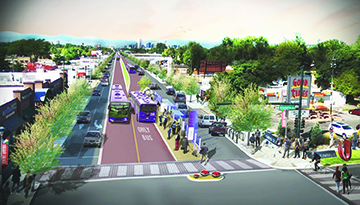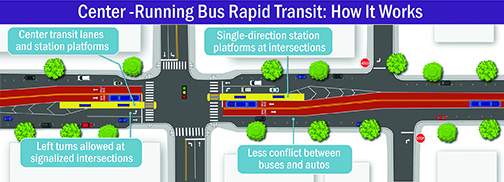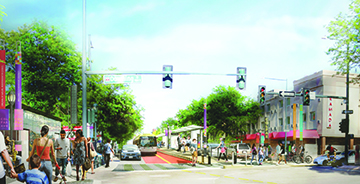“It seems as though all the devils were let loose on me; and if you think this is an exaggeration, ask anyone you meet who has lived in my district.”
- Schuyler Colfax
Colfax Avenue is revered, reviled and renowned — a pulsating conduit of commerce, crime and culture. If you live in Denver, you have inevitably been swept into its current, and the experience has no doubt left an indelible impression.

East Colfax: An artist’s rendition of what East Colfax might look like once the project is complete. This rendering is the intersection of Colfax and Krameria.
At any given moment along America’s longest avenue, nearly every type of human being on the move can be observed; pedestrians, drivers, motorcyclists, public transit customers, bicyclists, scooterists, skateboarders, and folks of questionable mental alertness doing their best to stay upright as they stagger along their way. According to a recent post on the RTD-Denver .com website, approximately 20,000 people travel this route every day going to and from work, play, and myriad other destinations. Related metrics posted on denver gov.org state, “Over the next 20 years, the corridor is expected to experience 25% growth in the number of travelers, 67% growth in employment and 25% growth in population. Denver cannot continue to grow and create more people-friendly spaces without efficiently moving more people through the East Colfax corridor.”
Current Projections
It is apparent that, with the current rate of growth in the Mile High City, the need to access this route will far outweigh the volume per hour capacity and thus, the Colfax Corridor BRT (Bus Rapid Transit) Project was initiated by the City and County of Denver. According to a quote on the Streets blog.org website from Jill Locantore (of the Denver Streets Project) this initiative, “is going to allow Colfax to carry more people than it does today. If you get more people out of their cars and on the buses, you have nearly infinite capacity for people, compared to very limited capacity for personal vehicles.”
Benefits vs. Drawbacks
The project proposes the replacement of side-running BRT with two repurposed center lanes for transit-only vehicles which passengers will access via elevated, wheelchair accessible platforms. Among the advantages listed on a denvergov.org web page are better-organized traffic flow, reduced crashes, improved travel efficiency, reduced conflicts with parking and other related curbside activities as well as streetscaping opportunities. Another listed benefit will be “improving pedestrian safety by moving transit lanes to the center.” This is where some highly questionable oversight may be at work, as the idea of people disembarking from public transit in the middle of Colfax and presumably making their way from the center to one side of the street elicits images of pedestrians being mangled by oncoming traffic a-la the 1980s video game Frogger. Sure, travelers will no doubt be instructed to use the crosswalk, but those who exit the BRT shuttle toward the rear of the vehicle — at the furthest point from the crosswalk — will inevitably take a shortcut to the sidewalk and simply jaywalk across the street. It is Colfax Avenue, after all — not exactly a place where people go to follow the rules. Add the winter conditions present in Denver half the year, the pedestrian danger could elevate to Ice Road Trucker Frogger.

BRT: The East Colfax Corridor Bus Rapid Transit (BRT) Project is still in the planning stages and may not see completion until 2028. Image: Denvergov.org
While popular among developers and city agency personnel, BRT presents a host of pressing concerns among residents and local business owners. The driving lanes will be reduced to just one lane for motor vehicles traveling east and west from Broadway in downtown Denver all the way to Yosemite St. in Aurora. Artist renditions of the proposed configuration present the very picture of congestion — a condition that could spell certain doom for streetside businesses.
Insight From A Bureaucracy Outsider

Velvet Elvis: Colfax Museum curator Jonny Barber (aka Velvet Elvis) has some transit enhancement ideas that are a bit more eccentric than those of the Colfax BRT.
Jonny Barber is a celebrated Denver musician, highly sought-after Elvis impersonator (The Velvet Elvis), curator of the Colfax Museum and administrator of the popular website ColfaxAvenue.org (along with wife Anistacia). Barber is considered by many to be the preeminent local authority of all things Colfax Avenue, including past iterations as a well-managed thoroughfare. He recalls how from the late 1800s until around 1950 or so, much of the traffic on Colfax was managed by streetcar trolleys which shuttled residents from west to east and back again. He contends that the original tracks still exist beneath a few layers of asphalt, and that perhaps a step back in time is a better approach. “Yes, we need transit on Colfax,” he begins. “Is BRT the answer? I don’t know but while we’re at it — we might as well do something a little sexier — like bring back the trolleys.”
A Crowded Kitchen
Meanwhile, BRT planners postulate the project will not reach completion until 2028, with a host of bureaucratic agencies acting as stakeholders, the process will no doubt be hindered by a quagmire of negotiations, objections, and red tape of every stripe. To elaborate on the complexity of the various agencies at play, CDOT (Colorado Department of Transportation) owns the actual road that is Colfax Avenue, RTD operates the public transportation vehicles, the City of Denver DOTI (Department of Transportation and Infrastructure) is responsible for maintenance and operation, and the FTA (Federal Transit Authority) is overseeing the entire BRT project. All parties must agree on how things will be managed, paid for, contracted, and carried out. Such a complex proposition is not just a traffic jam, but a multi-vehicle pileup that works well as a fitting metaphor for the future of Colfax Avenue.


